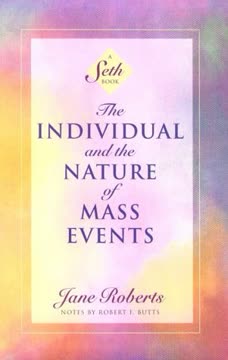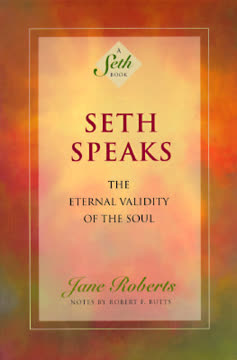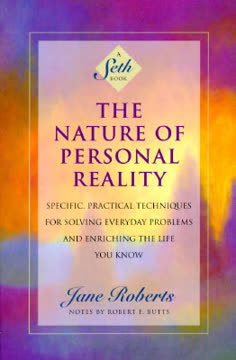Key Takeaways
1. You Create Your Own Reality
You make your own reality.
Personal reality is primary. The fundamental principle is that your subjective experience—your feelings, beliefs, and thoughts—is the direct cause of the physical reality you encounter. This isn't just a philosophical idea but the core mechanic of existence. While mass events seem to engulf the individual, they are ultimately composed of magnified individual realities.
Focus shapes experience. What you concentrate upon manifests in your life. If you focus on limitations, you create prisons; if you enjoy freedoms, you increase them. This applies to health, relationships, and all daily events. Your assessment of reality, based on your beliefs, dictates how your body and circumstances respond.
Conscious and unconscious creation. While conscious intent plays a role, much of this creation happens through deeper, often unconscious, psychological processes. Your inner self, aware of vast information, arranges events based on your core beliefs and desires, even those you may not be consciously aware of holding.
2. Mass Events Reflect Collective Beliefs
Inner reality and private experience give birth to all mass events.
Collective psychological states. Large-scale phenomena like epidemics, natural disasters, wars, and cultural shifts are not random accidents but the externalization of the collective psychological attitudes of the people involved. Shared despair, fear, or idealism can trigger biological or social manifestations.
Epidemics of belief. Diseases, for instance, are not solely biological; they involve sweeping psychological attitudes. Despair or apathy lowers defenses and activates viruses. Mass health programs focusing on symptoms and vulnerability can inadvertently generate fear, contributing to the very diseases they aim to prevent.
- Jonestown: An epidemic of beliefs leading to mass suicide.
- Three Mile Island: A manifestation of scientific cult beliefs and fears about power.
Events serve purposes. Mass events, while often appearing disastrous, serve collective purposes, sometimes forcing societal change or highlighting underlying issues that were ignored through conventional means. They are dramatic statements born from the psychological climate.
3. Framework 2: The Inner Creative Source
We will call that vast "unconscious" mental and universal studio Framework 2.
Reality's hidden dimension. Framework 1 is the physical world you perceive with your senses. Framework 2 is the non-physical, psychological medium from which Framework 1 emerges. It is the creative source, a realm of potential and activity that is the origin of all physical phenomena.
Inner ego's role. You have an "inner ego" that is fully conscious in Framework 2. This part of you deals with the formation of events, works with probabilities, and arranges the seemingly chance encounters and coincidences that manifest in your physical life. It is aware of your deeper intents and reincarnational activities.
Constant interaction. Framework 1 is constantly replenished and formed by Framework 2. The energy that fuels your thoughts and lights your cities originates here. Your physical body itself is a manifestation of its simultaneous reality in Framework 2, constantly being created from this inner dimension.
4. Death is Chosen and Purposeful
Inherently, each individual knows that he or she must die physically in order to survive spiritually and psychically.
Natural necessity. Dying is a biological, spiritual, and psychological necessity. The self outgrows the physical form, seeking new experience and development. Each individual knows this and chooses the timing of their death, even if not consciously.
Serving individual and species. Death serves the purposes of the individual, often occurring when they feel their life's purpose is fulfilled or when they seek a different state of existence. It also serves a purpose for the species, contributing to its vitality and evolution.
Not unbidden. No death comes unbidden, whether from illness, accident, or natural disaster. Those involved in mass fatalities have, on a deeper level, chosen to participate, often using the event as a dramatic exit or a catalyst for transformation.
5. Trust Your Impulses
Ideally, your impulses are always in response to your own best interests—and, again, to the best interests of your world as well.
Innate guidance system. Impulses are natural, spontaneous urges toward action that arise from unconscious knowledge and the personality's needs and potentials. They are meant to guide you toward fulfilling your unique abilities and contributing constructively to the world.
Doorways to action. Impulses provide the impetus for motion, both physical and mental. They open up choices and allow you to exert your natural power, impressing your environment effectively. They are as vital and altruistic as your physical organs.
Distrust causes problems. Society has taught a deep distrust of impulses, viewing them as chaotic or originating from a "nefarious subconscious." This distrust leads to indecision, blocks beneficial action, and can cause dammed-up energy to explode in distorted, destructive ways when denied natural expression.
6. Fear and Powerlessness Distort Idealism
Only when the natural impulse (to act constructively) is denied consistently does the idealist turn into a fanatic.
Idealism's dark side. Idealism, the desire to make the world better, is inherent. However, when coupled with beliefs in personal powerlessness and a conviction that the world is inherently evil or cannot be changed, idealism can become distorted.
Fanaticism's roots. Fanatics are often unfulfilled idealists who feel powerless. They seek joint action where individual responsibility is dispersed, demanding immediate, often violent, means to achieve grandiose, vague ideals. They have tunnel vision, attacking anything that challenges their rigid beliefs.
- Hitler: An idealist whose fear and belief in man's evil led to fanatical pursuit of a distorted "good."
- Jonestown: Idealists who felt powerless and sought refuge in a rigid system, leading to mass suicide.
Means vs. ends. Fanaticism justifies any means, including killing, in pursuit of an ideal. This is a fundamental distortion, as the sacredness of life cannot be sacrificed for convenience or even perceived "good." True idealism works through constructive individual action.
7. Cults (Religious & Scientific) Offer False Security
There are religious cults, and there are also scientific ones.
Closed belief systems. Cults, whether religious or scientific, arise from fear and a deep distrust of the self and the spontaneous nature of existence. They offer a seemingly safe, controlled environment with rigid rules and dogma, relieving individuals of the "burden" of personal responsibility and decision-making.
Paranoia and control. Paranoia, a manifestation of extreme distrust, can lead individuals to create completely private, distorted realities. Mass paranoia, fueled by cults, projects fear outward onto perceived enemies, justifying extreme measures and reinforcing the belief that the world is unsafe and the self is untrustworthy.
Science as a cult. Science, when operating as a cult, also exhibits rigid dogma, an exclusive language, and a distrust of subjective experience and spontaneous processes. Its belief in an accidental, meaningless universe devalues life and can justify risks or sacrifices in the name of progress or perceived "greater good."
8. Nature and Consciousness are Inherently Good
Despite all "realistic" pragmatic tales to the contrary, the natural state of life itself is one of joy, acquiescence with itself— a state in which action is effective, and the power to act is a natural right.
Universe of good intent. The universe and all life within it are manifestations of creative energy with an inherent thrust toward growth and value fulfillment. This is a direct contradiction to scientific theories positing an accidental, meaningless cosmos or religious doctrines emphasizing inherent sinfulness.
Consciousness is primary. Consciousness is not a byproduct of physical mechanisms but is primary, existing before and independent of physical form. Every particle, from atoms to molecules, possesses consciousness and an impetus for development, cooperatively choosing the forms they take.
Biological spirituality. Man is born with a natural religious knowledge, a biological spirituality, recognizing his inherent goodness and connection to the universe's source. This innate sense of worth and purpose is often suppressed by societal beliefs that emphasize flaws and powerlessness.
9. Imagination Shapes Reality
Your physical world, with all of its civilizations and cultural aspects, and even with its technologies and sciences, basically represents the species' innate drive to communicate, to move outward, to create, and to objectify sensed inner realities.
Imagination as source. The physical world and all its events originate in the imagination. Myths, fantasies, dreams, and thoughts are not mere subjective ephemera but powerful psychic fabrications that form the patterns and blueprints for physical reality.
Myths become facts. When myths are accepted collectively, they become the perceived facts of a civilization, structuring experience and providing the lens through which events are interpreted. Religions and sciences, in this sense, are built upon mythical constructs.
Dreams and reality. Dreams are a key interface between Framework 1 and Framework 2, where the inner ego processes information and explores probabilities. Even if not consciously remembered, dream messages are received and influence daily experience, often triggering insights or guiding actions.
10. Natural Law is Based on Goodness and Cooperation
There are natural laws, then, that guide all kinds of life, and all realities—laws of love and cooperation—and those are the basic needs of which I am speaking.
Inner laws of existence. Beyond the perceived "laws of nature" like gravity, there are deeper, underlying laws that pervade all realities. These are laws of love, cooperation, and value fulfillment, guiding each being toward its own development and contributing to the fulfillment of all.
Cooperation in nature. Nature operates through a vast cooperative venture, not merely a struggle for survival of the fittest. Species interact in ways that ensure mutual fulfillment, a communion of consciousness often missed by human perception focused on competition.
Innate goodness. Man is born with an in-built recognition of his own goodness, a desire to fulfill abilities, and a drive to add value to life. This natural law is the basis for true human nature, often obscured by societal beliefs in inherent badness, leading to distorted actions and suffering.
Last updated:
FAQ
1. What is The Individual and the Nature of Mass Events by Jane Roberts about?
- Exploration of consciousness: The book examines how individual consciousness shapes and merges into mass events, influencing everything from epidemics to social movements.
- Frameworks of reality: It introduces two frameworks—Framework 1 (physical reality) and Framework 2 (inner, creative reality)—to explain how subjective experiences become collective events.
- Role of beliefs and imagination: The text highlights how personal and cultural beliefs, myths, and imagination are central to the creation of both private and mass realities.
- Personal responsibility: Readers are encouraged to recognize their role as creators of experience, both individually and collectively.
2. Why should I read The Individual and the Nature of Mass Events by Jane Roberts?
- Unique perspective on reality: The book offers a distinctive view on how thoughts, beliefs, and emotions directly influence both personal and societal events.
- Empowerment and self-awareness: It provides practical advice for taking responsibility for your reality and understanding your impact on the world.
- Insight into mass phenomena: Readers gain a deeper understanding of the psychological and spiritual roots of mass events like epidemics, disasters, and social upheavals.
- Tools for personal growth: The book encourages trust in impulses, use of imagination, and conscious creation of a fulfilling life.
3. What are the key takeaways from The Individual and the Nature of Mass Events by Jane Roberts?
- You create your own reality: Personal beliefs and emotions are the foundation of both private and mass experiences.
- Trust your impulses: Everyday impulses are constructive and guide spiritual and species growth.
- Imagination shapes experience: Imagination and myths are powerful creative forces that influence both individual lives and civilizations.
- Responsibility and idealism: Accepting responsibility for your actions and practicing your ideals are essential for personal and societal development.
4. What are Framework 1 and Framework 2 in Jane Roberts’ The Individual and the Nature of Mass Events?
- Framework 1 – Physical reality: This is the tangible, cause-and-effect world where events are experienced as concrete and factual.
- Framework 2 – Inner creative reality: A vast, dynamic psychic realm where all possibilities exist and from which physical events are materialized.
- Interaction between frameworks: Events in Framework 1 are sourced from Framework 2, with both realities coexisting and influencing each other.
- Practical implication: Understanding these frameworks helps readers see how inner thoughts and beliefs shape outer experiences.
5. How does Jane Roberts define the relationship between individual impulses and mass events in The Individual and the Nature of Mass Events?
- Impulses as creative language: Impulses are described as the psyche’s language, essential for spiritual growth and positive contribution to humanity.
- Formation of mass events: Individual impulses and beliefs combine and magnify, resulting in mass reactions like epidemics, wars, and cultural shifts.
- Good intent of impulses: All impulses are fundamentally constructive, aiming to enhance both personal lives and civilization.
- Societal impact: Distrust or repression of impulses can lead to frustration, blocked creativity, and even destructive mass behavior.
6. How does The Individual and the Nature of Mass Events by Jane Roberts explain the connection between subjective reality and physical events?
- Subjective world as source: Thoughts, feelings, and beliefs are the foundation from which physical events emerge.
- Direct connection: The book asserts that subjective reality at any moment is directly linked to the physical events experienced.
- Role of focus and belief: Where individuals place their attention and what they believe determines the events they encounter.
- Historical context: Early humans saw subjective and objective realities as one, but modern society has separated them, requiring conscious bridging.
7. What is Jane Roberts’ perspective on the causes of epidemics and natural disasters in The Individual and the Nature of Mass Events?
- Psychological and biological interplay: Epidemics and disasters are seen as reflections of collective psychological states, not just biological phenomena.
- Mass suicide phenomenon: Epidemics can represent a form of mass suicide, where individuals semiconsciously choose death for larger purposes or protest.
- Body-mind connection: The body responds to mental states, and diseases can be triggered or suppressed by beliefs and emotions.
- Social context: Such events often mirror societal despair, unrest, or the need for transformation.
8. How does The Individual and the Nature of Mass Events by Jane Roberts address the role of beliefs about good and evil in shaping reality?
- Belief systems as filters: Beliefs about good and evil act as screens through which all experience is judged and interpreted.
- Impact of religion and science: Organized religion and scientific worldviews shape collective meaning, responsibility, and creativity.
- Mass behavior and fanaticism: Misguided beliefs can lead to mass tragedies, cults, and destructive behavior in pursuit of idealized goods.
- Personal responsibility: The book encourages examining and consciously choosing beliefs to foster constructive experiences.
9. What does Jane Roberts say about viruses, disease, and consciousness in The Individual and the Nature of Mass Events?
- Viruses as intelligent entities: Viruses are described as cooperative, intelligent, and part of the body’s natural balance.
- Disease as creative experimentation: Illnesses are seen as biological experiments or evolutionary processes that can serve species-wide purposes.
- Mind-body connection: Thoughts and beliefs have chemical realities that influence physical health and immunity.
- Role of beliefs in healing: The belief in medical procedures, such as inoculations, can be as influential as the procedures themselves.
10. How does The Individual and the Nature of Mass Events by Jane Roberts describe the role of imagination and myths in shaping reality?
- Myths as creative sources: Myths are powerful psychic fabrications that form the inner foundation of civilizations and personal realities.
- Imagination as a creative force: Imagination is the medium through which individuals direct experience and shape both their lives and societies.
- Interplay of myth and fact: Physical reality is built upon a foundation of fantasy and myth, with beliefs and imagination coloring all experience.
- Practical advice: Cultivating positive, constructive mental states and imaginative visions can beneficially influence reality.
11. What is the significance of dreams and creativity in human evolution according to Jane Roberts’ The Individual and the Nature of Mass Events?
- Dreams as creative source: Dreams are vital for human development, enabling language, invention, and the extension of consciousness.
- Inner and outer realities: The physical world and species are seen as manifestations of inner mental patterns or "cosmic underpaintings."
- Unique human dreaming: Humans possess a specialized dreaming consciousness that blends physical and nonphysical elements, fostering creative evolution.
- Bridge to broader knowledge: Dreams and trance states allow access to memories and knowledge beyond linear time.
12. What practical advice does Jane Roberts offer in The Individual and the Nature of Mass Events for individuals seeking to change their lives and the world?
- Start with self-trust: Accept your own worth and trust your impulses as guides for personal and collective growth.
- Act constructively: Take practical, worthy steps toward your ideals, avoiding destructive or fanatical methods.
- Use imagination consciously: Recognize and harness the creative power of imagination and beliefs to shape your life and environment.
- Collective impact: Understand that individual thoughts and actions contribute to the mental atmosphere of society, influencing mass events and cultural evolution.
Review Summary
The Individual and the Nature of Mass Events by Jane Roberts receives mostly positive reviews, with readers praising its profound insights into consciousness, reality creation, and mass events. Many find the book thought-provoking and life-changing, appreciating Seth's explanations of how individual thoughts and beliefs shape personal and collective experiences. Some readers note the book's relevance to current world events and its emphasis on personal responsibility. While a few find it challenging to understand, most reviewers recommend it as a valuable metaphysical text that offers a unique perspective on human existence and spirituality.
Download PDF
Download EPUB
.epub digital book format is ideal for reading ebooks on phones, tablets, and e-readers.







